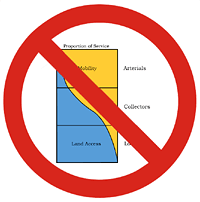Download a print version of this essay.
Part One of this essay covers the background, characteristics and drawbacks of functional classification, and evaluates some of the leading alternatives. Part Two continues by proposing a replacement, a sustainable transportation network classification, covering the block-scale and neighborhood-scale relationships. Part Three concludes by covering the city-scale relationship and the congestion-related impacts of a sustainable network.
City Scale
The ideal pattern of regional growth has been debated at least since the 19th century. In the 1960s and 70s the focus of the debate sharpened on efficiency and sustainability, and the “Compact City” was suggested to be the ideal. The Compact City redirects all growth into a single urban core, maximizing density while minimizing the consumption of farms, forests and agricultural land. It explicitly counteracted the dominant trend of decentralized suburban sprawl.
Some of the benefits of the Compact City idea have been confirmed by researchers. Cities with higher density and more compact form have much less per capita driving (Newman and Kenworthy, 1999). In existing cities, the trend of sprawling suburban growth causes an explosion in the amount of auto driving; a policy of refocusing growth, mixed use and transit in the urban core will halt that explosion and slightly reduce the amount of driving (Simmonds and Coombe, 2000).

Analysis of city-scale development patterns shows that focusing growth on high-capacity transit nodes will have the greatest CO2 reduction effect. Image credit: Eliot Allen, “Cool Spots”

 Every field has its foundational working concepts and the field of traffic engineering is no exception. It has a concept called functional classification, which is the core, guiding idea underlying the roadway system of the United States and many other nations. Functional classification is the conceptual foundation of the auto-dependent built environments where most Americans live.
Every field has its foundational working concepts and the field of traffic engineering is no exception. It has a concept called functional classification, which is the core, guiding idea underlying the roadway system of the United States and many other nations. Functional classification is the conceptual foundation of the auto-dependent built environments where most Americans live.